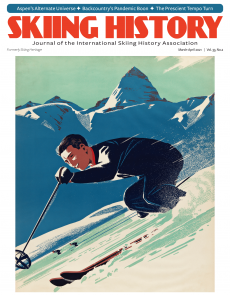SKIING HISTORY
Editor Greg Ditrinco
Consulting Editor Seth Masia
Art Director Edna Baker
Editorial Board
Seth Masia, Chairman
John Allen, Andy Bigford, John Caldwell, Jeremy Davis, Kirby Gilbert, Paul Hooge, Jeff Leich, Bob Soden, Ingrid Wicken
Founding Editors
Morten Lund, Glenn Parkinson
To preserve skiing history and to increase awareness of the sport’s heritage
ISHA Founder
Mason Beekley, 1927–2001
ISHA Board of Directors
Chan Morgan, Chairman
Seth Masia, President
Wini Jones, Vice President
Jeff Blumenfeld, Vice President
John McMurtry, Vice President
Chan Morgan, Treasurer
Einar Sunde, Secretary
Richard Allen, Skip Beitzel, Michael Calderone, Art Currier, Dick Cutler, Chris Diamond, David Ingemie, Joe Jay Jalbert, Rick Moulton, Wilbur Rice, Charles Sanders, Bob Soden (Canada)
Presidential Circle
Christin Cooper, Billy Kidd, Jean-Claude Killy, Bode Miller, Doug Pfeiffer, Penny Pitou, Nancy Greene Raine
Business & Events Manager
Kathe Dillmann
P.O. Box 1064
Manchester Center VT 05255
(802) 362-1667
kathe@skiinghistory.org
Membership Services
Laurie Glover
(802) 375-1105
laurie@skiinghistory.org
Corporate Sponsorships
Peter Kirkpatrick
(541) 944-3095
peterk10950@gmail.com
Bimonthly journal and official publication of the International Skiing History Association (ISHA)
Partners: U.S. Ski and Snowboard Hall of Fame | Canadian Ski Museum and Hall of Fame
Alf Engen Ski Museum | North American Snowsports Journalists Association | Swiss Academic Ski Club
Skiing History (USPS No. 16-201, ISSN: 23293659) is published bimonthly by the International Skiing History Association, P.O. Box 1064, Manchester Center, VT 05255.
Periodicals postage paid at Manchester Center, VT and at additional mailing offices. Postmaster: Send address changes to ISHA, P.O. Box 1064, Manchester Center, VT 05255
ISHA is a 501(c)(3) public charity. EIN: 06-1347398
Written permission from the editor is required to reproduce, in any manner, the contents of Skiing History, either in full or in part.
Resorts: What Might Have Been
Before Aspen, Ashcroft and Mount Hayden promised a cable car, ‘immense schusses,’ a village for 2,000. Then World War II intervened.
Photo above: A map drawn by Roch of his vision for a ski resort in the greater Aspen area. Courtesy Aspen Historical Society.
It is difficult now to realize that Aspen’s skiing development did not start in town but out on Castle Creek, where the Highland Bavarian Lodge housing two European guides was to offer ski touring for wealthy clients.
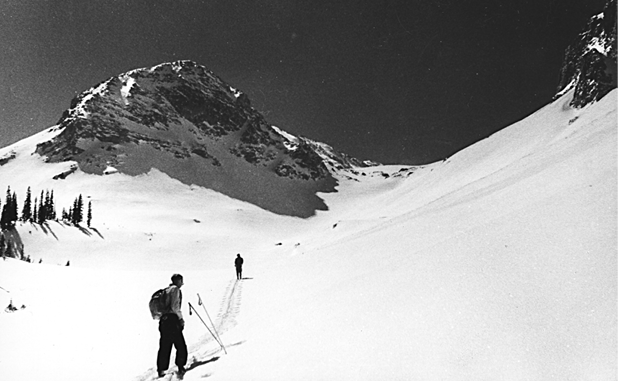
en route to Mt. Hayden in 1937, scouting
for the development of a ski area. Aspen
Historical Society.
What a curious tale. During the summer of 1936, one-time Aspen resident Tom Flynn was peddling mining claims and happened on Billy Fiske at a party in Pasadena, California. Fiske came from a wealthy Chicago banking family. He was a sometime dilettante Hollywood film maker, flyer, member of the gold-winning Olympic bobsled team in 1928, and captain of the sled that was victorious four years later at the Lake Placid Games.
Fiske was as well-known on the Cresta run in Switzerland as he was in England’s society circles. Flynn showed him photographs of the mining claims but it was the area as a possible ski region that attracted Fiske, just as those photos had impressed Ted Ryan, New York banker, heir to the Anaconda Copper fortune and brother of Mont Tremblant developer Joe Ryan.
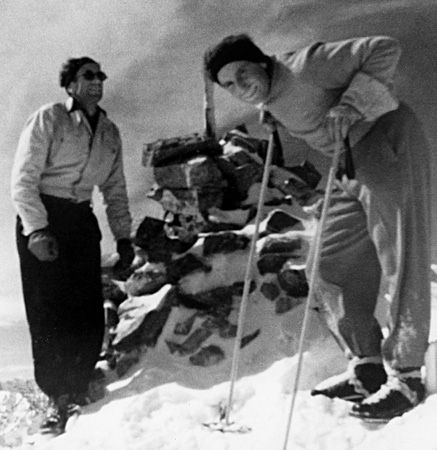
summit. AHS.
Fiske, Ryan, and Flynn bought land on Castle Creek, started construction of the Highland Bavarian Lodge, hired Swiss skier, mountaineer and already avalanche expert, André Roch, along with Gunther Langes, a south Tyrolian who had organized the world’s first giant slalom, on Italy’s Marmolata in 1935. The two made the trans-Atlantic crossing and arrived in Aspen in December 1936.
We know much of this from the article Roch wrote for the Swiss ski journal Der Schneehase. From this article and from Ted Ryan’s papers, deposited with the Aspen Historical Society, “what might have been” can be pieced together. For admirers of “what if” history, it makes for a fascinating study.
Roch and Langes believed they were being hired to scout out land in Colorado where a major ski resort might be financed, much the way Count Felix Schaffgotsch had done a year earlier for Union Pacific Railroad’s chairman Averell Harriman, which led to Sun Valley, America’s first purpose-built winter ski resort.
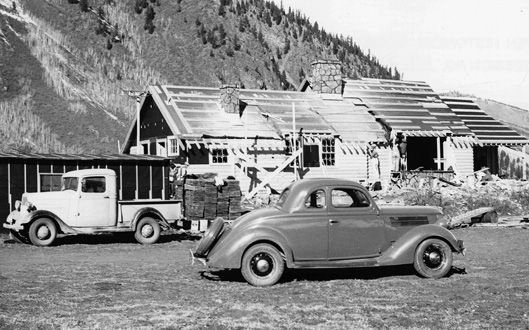
Lodge, 1936. AHS.
However, when the two arrived in Aspen they discovered “with some unease” that they were not to explore the Rocky Mountains, since Fiske and Ryan had already chosen the location. Their remit was “simply to verify its excellence, to check on terrain and climate,” all to ensure that the location was suitable for “the launching of a big winter sports resort.” However charming the lodge might be, Roch was immediately critical of the setting of the Highland Bavarian Lodge at the juncture of Castle Creek and Conundrum, about five miles from Aspen.
In a steep-sided, avalanche-prone valley, with wind-battered snowfields far above the tree line, this was not the St. Moritz of America. Worst of all, wealthy guests from Boston, New York, Philadelphia and Chicago had already been booked into the Lodge and expected to revel in pristine snowfields, guided by experienced Europeans…and it was a snow poor December.
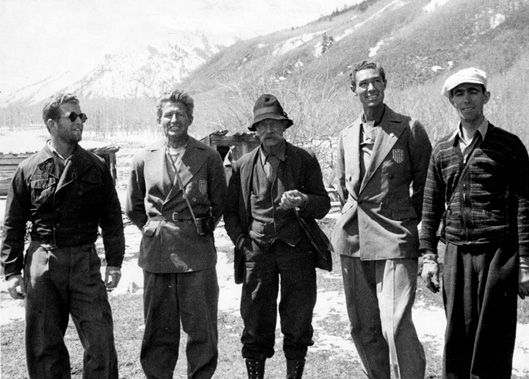
Bob Rowan, Mike Magnifico case the
joint, 1937. Charles Grover, AHS.
The Lodge was not even finished, so Roch and Langes bedded down in Aspen’s Jerome Hotel and took clients up towards what is now Little Annie. Fiske and Ryan saw the town of Aspen, with its road connections to Glenwood Springs and over Independence Pass, and its railroad, as the hub of skiing. Before Roch left in June 1937, he had marked out a trail for the newly-formed ski club to cut. This became known as the Roch Run.
But 12 miles out of Aspen, farther on up the Castle Creek valley, lay Ashcroft, population one, remnant of a mining outpost. Now, said Roch, there was a real possibility as it sat in a natural bowl surrounded by 12,000-foot peaks. With plenty of options for ski runs on east and north-facing slopes, it would be “a resort without competition.”
Roch climbed from Ashcroft towards Hayden Peak on January 15, 1937. He turned back before reaching the top but had seen enough of the Conundrum valley and had admired the surrounding peaks: Pyramid, Snowmass, Castle, Cathedral and most spectacularly, the Maroon Bells.
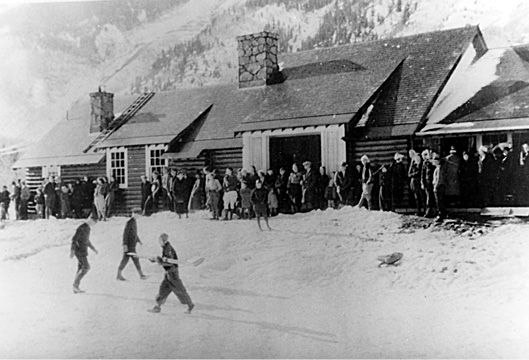
1937 at the Highland Bavarian
Lodge. AHS.
That spring Roch, Langes and Fiske climbed Hayden. Soon after, renowned Eastern skiers like Otto Schniebs came out to be amazed by the spectacular West. And from Denver came ski manufacturer Thor Groswold and skiing man-about-town Frank Ashley. Other areas were explored, too.
The conclusion was inescapable: Fiske and Ryan had untouched resort territory. The road into Ashcroft would need rebuilding and in some places re-routing to avoid avalanches. Hotels were planned to hold 2,000 skiers. That figure was gauged to make a cable car up Mount Hayden economically feasible. The accompanying map indicates the lifts with the mid station marked leading to a second lift to reach a hotel at the top, some 3,000 feet above the valley floor.
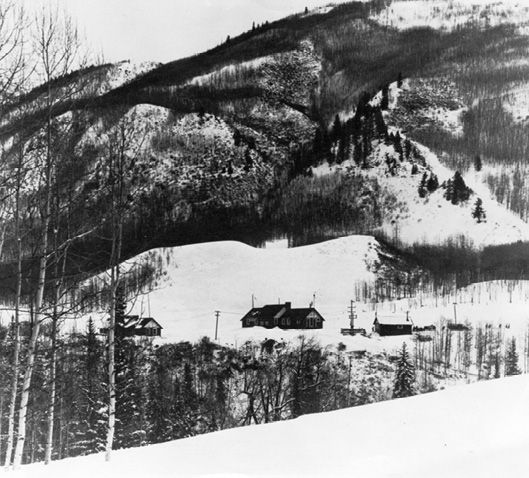
Beginners were not forgotten, with the more gentle ski fields near the road, and two jumps were planned. Roch added comments, underscoring the importance of slopes on the north and eastern sides; south- and west-facing slopes had too much sun, too little snow and the western side was subject to winds. The first of two connecting chairs was proposed from Ashcroft to Monument. The second chair was to reach the summit of Electric Peak, providing a 2,000-foot-plus vertical.
This was vital because it would give access to Hayden’s ridge and thus to Cathedral Lake and on down to Pine, Sandy and Sawyer creeks. From there, transportation would be needed to get back to Ashcroft. Altitude was the drawback. Topping out at 13,600 feet, bad weather would shut the lift complex down. Even so “this splendid ski-area would not be developed into its proper capacity without it.” Descents from the top could be compared to the Parsenn. With “immense Schusses,” Roch skied down to Ashcroft in twenty minutes. He was ecstatic. And the valley below was long and broad, large enough “to combine hotels, bungalows and parking places.” A Swiss village was envisioned.
In Denver, the Colorado legislature voted a $650,000 bond for the lifts. Ashcroft was going to be the “Williamsburg of the Old West,” enthused architect Ellery Husted. Ted Ryan was all enthusiasm, too. As he recalled for the documentary Legends of American Skiing: “We had an area bigger than Zermatt.” “We were all set to go, and then ‘bang’ World War II came and Billy Fiske was shot down during the Battle of Britain.” Fiske, flying a Hurricane for 601 Squadron, was badly wounded when his plane was hit. He managed to fly his machine home, but died in hospital two days later. His death and the war ended what might have been the Mount Hayden development.
Maybe it is not all bad; backcountry skiers certainly like the way it has all turned out. The Ashcroft Touring Center became the first self-sustaining cross-country center in the U.S. in 1971, and its Pine Creek Cookhouse provides a uniquely memorable dining experience. And, as patrons will attest, the views are “unreal.” 
Table of Contents

Corporate Sponsors
ISHA deeply appreciates your generous support!
WORLD CHAMPIONSHIP ($3,000 AND UP)
Gorsuch
Polartec
WORLD CUP ($1,000)
Aspen Skiing Company
BEWI Productions
Bogner
Boyne Resorts
Dale of Norway
Darn Tough Vermont
Dynastar | Lange | Look
Fairbank Group: Bromley, Cranmore, Jiminy Peak
Gordini USA Inc. | Kombi LTD
HEAD Wintersports
Hickory & Tweed Ski Shop
Intuition Sports, Inc.
Mammoth Mountain
Marker-Volkl USA
Outdoor Retailer
Rossignol
Ski Area Management
Ski Country Sports
Snowsports Merchandising Corporation
Sport Obermeyer
Sports Specialists, Ltd.
Sun Valley Resort
Vintage Ski World
Warren and Laurie Miller
World Cup Supply, Inc.
GOLD ($700)
Race Place | BEAST Tuning Tools
The Ski Company (Rochester, NY)
Thule
SILVER ($500)
Alta Ski Area
Boden Architecture PLLC
Dalbello Sports
Ecosign Mountain Resort Planners
Fera International
Holiday Valley
Hotronic USA, Inc. | Wintersteiger
MasterFit Enterprises
McWhorter Driscoll, LLC
Metropolitan New York Ski Council
New Jersey Ski & Snowboard Council
NILS, Inc.
Russell Mace Vacation Homes
Schoeller Textile USA
Scott Sports
Seirus Innovations
SeniorsSkiing.com
Ski Utah
Swiss Academic Ski Club
Tecnica Group USA
Trapp Family Lodge
Western Winter Sports Reps Association
World Pro Ski Tour


